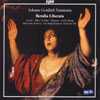Naumann Betulia Liberata
What a lesser known Dresden composer made of an Apocryphal beheading
View record and artist detailsRecord and Artist Details
Composer or Director: Johann Gottlieb Naumann
Genre:
Vocal
Label: CPO
Magazine Review Date: 13/2006
Media Format: Super Audio CD
Media Runtime: 96
Mastering:
Stereo
DDD
Catalogue Number: CPO777 063-2

Tracks:
| Composition | Artist Credit |
|---|---|
| Betulia liberata |
Johann Gottlieb Naumann, Composer
(Das) Kleine Konzert Hans Jörg Mammel, Tenor Harry van der Kamp, Bass Hermann Max, Conductor Johann Gottlieb Naumann, Composer Markus Schäfer, Tenor Nele Gramss, Soprano Rheinische Kantorei Salomé Haller, Soprano |
Author: David Vickers
Johann Gottlieb Naumann (1741–1801) received his first musical training at the Kreuzschule in Dresden, and probably studied with Hasse. Although engaged in successful opera projects from Sweden to Italy, he kept returning to Dresden. In 1796 Prince Elector Friderich August III wanted him to set Metastasio’s 1734 libretto Betulia liberata for the Easter Saturday celebration. Poor health prevented him from fulfilling the commission in time but he later presented his completed score to the Prince, who arranged for a belated performance several years after the composer’s death.
The plot is taken from the Apocryphal story of Judith’s beheading of Holofernes. We never meet the villain but his vanity and cruelty are brilliantly described in the aria “Terribile d’aspetto” (superbly sung by Harry van der Kamp). Naumann’s accompanied recitatives, arias and choruses weave and flow without a break. Rheinische Kantorei’s finely crafted choruses often carry the action forward. Das Kleine Konzert play charming arias and immaculately paced accompanied recitatives with sensitivity and stylishness.
Nele Gramss and Salomé Haller are impressive, especially the latter in her persuasively delivered simile aria “Quel nocchier che in gran procella”, full of demanding wide leaps and taxing coloratura. Markus Schäfer is on mellifluous form in “Se Dio veder tu vuoi”, in which creative solos for flute and cello depict Metastasio’s attempt to prove that God exists using logical argument.
This enjoyable performance perfectly illustrates Naumann’s position as the most important Dresden composer between Hasse and Weber. Those who explore the remote byways of 18th-century music drama will find much to admire and enjoy here.
The plot is taken from the Apocryphal story of Judith’s beheading of Holofernes. We never meet the villain but his vanity and cruelty are brilliantly described in the aria “Terribile d’aspetto” (superbly sung by Harry van der Kamp). Naumann’s accompanied recitatives, arias and choruses weave and flow without a break. Rheinische Kantorei’s finely crafted choruses often carry the action forward. Das Kleine Konzert play charming arias and immaculately paced accompanied recitatives with sensitivity and stylishness.
Nele Gramss and Salomé Haller are impressive, especially the latter in her persuasively delivered simile aria “Quel nocchier che in gran procella”, full of demanding wide leaps and taxing coloratura. Markus Schäfer is on mellifluous form in “Se Dio veder tu vuoi”, in which creative solos for flute and cello depict Metastasio’s attempt to prove that God exists using logical argument.
This enjoyable performance perfectly illustrates Naumann’s position as the most important Dresden composer between Hasse and Weber. Those who explore the remote byways of 18th-century music drama will find much to admire and enjoy here.
Discover the world's largest classical music catalogue with Presto Music.

Gramophone Digital Club
- Digital Edition
- Digital Archive
- Reviews Database
- Full website access
From £8.75 / month
Subscribe
Gramophone Full Club
- Print Edition
- Digital Edition
- Digital Archive
- Reviews Database
- Full website access
From £11.00 / month
Subscribe
If you are a library, university or other organisation that would be interested in an institutional subscription to Gramophone please click here for further information.




